|
Insignia of China
(Part II)
Many varieties of national insignia
used by the Red Army of China in the years leading up to the formation of the People's
Republic of China are illustrated below.
Mao Tse-tung's guerrilla forces
first came into contact with military aircraft in 1925 when, in a temporary alliance with
the KMT, the Aviation Bureau of the KMT was set up in November 1925. Using Soviet pilots
and ground crew, this formed the nucleus of the future KMT Air Force. An aviation element
operated with the Red Army's IV Corps between 1926 and 1927.
A Fukien People's Republic Air Force
also operated from Hangkow between 1933 and 1938 (see page 88 for inventory). Aviation was
set up on a more formal basis when the Red Army of China Air Force was set up in 1935.
This air arm survived until the establishment of the establishment of the People's
Liberation Army Air Force in July 1946.
Other important steps in Communist
Chinese air power included the setting up of the Aviation Bureau of the Military
Commission of the Communist Party of China in March 1946 and the formation of a Soviet run
Flying School in Harbin, Manchuria in 1948.

First aircraft of Red Army 1930
 On
28th Feb., 1930, a National Chinese reconnaissance aircraft O2U-4 Corsair was
force landed due to running out of fuel. The Red Army captured it. It was repainted and
with red star and named after ‘Lenin’. It was later used against the Chinese National Government.
On
28th Feb., 1930, a National Chinese reconnaissance aircraft O2U-4 Corsair was
force landed due to running out of fuel. The Red Army captured it. It was repainted and
with red star and named after ‘Lenin’. It was later used against the Chinese National Government.
 |
 |
|
|
|
Lenin |
Lenin |
|
|

Sinkiang Aviation School 1936
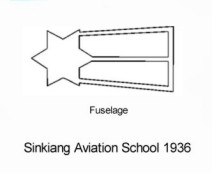 Under the agreement of Sinkiang autonomy and Chinese
Communist, a few officers selected from Red Army were sent to the Sinkiang Aviation School
for basic flight training. Aircrafts used included Polikarpov R-5, I-15 and I-16. Under the agreement of Sinkiang autonomy and Chinese
Communist, a few officers selected from Red Army were sent to the Sinkiang Aviation School
for basic flight training. Aircrafts used included Polikarpov R-5, I-15 and I-16.
 |
|
|
|
|
Polikarpov
R-5 |
|
|
|

Red Army of China Air Force 1944
 This style of marking was applied to a Japanese Army Air Force
Tachikawa Ki.54 Hickory captured by Communist forces in Northern China in 1944. Chinese
characters were painted over the Japanese roundels in White, representing CHICOM (Chinese
Communists). A standard KMT Blue and White roundel was painted on the tail, presumably as
an insurance against attack by Allied warplanes.
This style of marking was applied to a Japanese Army Air Force
Tachikawa Ki.54 Hickory captured by Communist forces in Northern China in 1944. Chinese
characters were painted over the Japanese roundels in White, representing CHICOM (Chinese
Communists). A standard KMT Blue and White roundel was painted on the tail, presumably as
an insurance against attack by Allied warplanes.
 |
|
|
|
|
Ki-54 |
|
|
|

Red Army of China Air Force 1946-1947
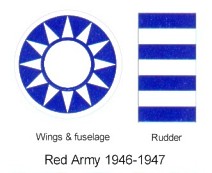 During
the initial setup of the Communist Aviation School in Manchuria, all aircraft wore the
same National Chinese roundel with white border and with 4 blue and 3 white strips on the
rudder. During
the initial setup of the Communist Aviation School in Manchuria, all aircraft wore the
same National Chinese roundel with white border and with 4 blue and 3 white strips on the
rudder.
 |
 |
|
|
|
Ki-55 |
Ki-55 |
|
|

-
Red Army of China Air Force 1947-1949
 To
avoid miss up with National Chinese aircraft, all Red Chinese aircraft wore this national
marking between 1947 and 1950. It was used mainly by aircraft from the Communist Aviation
School in Manchuria and the 1st Squadron of the Air Combat Group.
Representative types: Kawasaki Ki.45, Mitsubishi Ki.30 Ann, Mitsubishi Ki.46 and Nakajima
Ki.43 Hayabusa, Tachikawa Ki-55. To
avoid miss up with National Chinese aircraft, all Red Chinese aircraft wore this national
marking between 1947 and 1950. It was used mainly by aircraft from the Communist Aviation
School in Manchuria and the 1st Squadron of the Air Combat Group.
Representative types: Kawasaki Ki.45, Mitsubishi Ki.30 Ann, Mitsubishi Ki.46 and Nakajima
Ki.43 Hayabusa, Tachikawa Ki-55.
 |
 |
|
|
|
Ki-30 |
Ki-30 |
|
|

People's Liberation Army Air Force
1945-1949
 An
alternative marking was this simple star, worn on the wings and fuselage of several types,
notably the Manshu Ki.79a and Ki.79b trainers in North China and Manchuria, and at the
Sian Air Academy. An
alternative marking was this simple star, worn on the wings and fuselage of several types,
notably the Manshu Ki.79a and Ki.79b trainers in North China and Manchuria, and at the
Sian Air Academy.

People's Liberation Army Air Force
1946-1950
 This
simplified curved star and circle roundel was used on several types between 1946 and 1950.
This was the first national marking that included Chine characters representing the
formation date of the Red Army of China on 1 August 1928. Representative types Kawasaki
Ki.45 Nick, Mitsubishi Ki.30 Ann, Mitsubishi Ki.46 Dinah Mitsubishi ki.51 Sonia and
Tachikawa Ki.55 Ida. This
simplified curved star and circle roundel was used on several types between 1946 and 1950.
This was the first national marking that included Chine characters representing the
formation date of the Red Army of China on 1 August 1928. Representative types Kawasaki
Ki.45 Nick, Mitsubishi Ki.30 Ann, Mitsubishi Ki.46 Dinah Mitsubishi ki.51 Sonia and
Tachikawa Ki.55 Ida.

People's Liberation Army Air Force
1946-1949
 This
star insignia with bars in Red and White was yet another national marking to make its
appearance around 1946. This style of marking was applied to many of the aircraft included
in the list on this page. This
star insignia with bars in Red and White was yet another national marking to make its
appearance around 1946. This style of marking was applied to many of the aircraft included
in the list on this page.
 |
 |
|
|
|
MiG-15 |
MiG-15 |
|
|

People's Liberation Army Air Force
from 1946
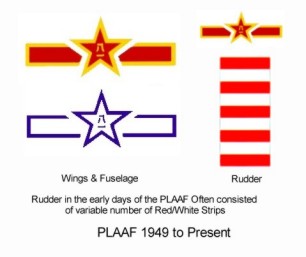 The
familiar Star and bar Chinese national insignia made its first appearance in 1949, and has
continued in use up to the present day. The
familiar Star and bar Chinese national insignia made its first appearance in 1949, and has
continued in use up to the present day.
 |
 |
 |
|
|
P-51 |
P-51
& B-25 |
H-6
(Tu-16) |
|

People's Liberation Army Air Force
(2nd Division)
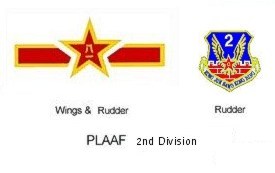 In 2001, some of the aircrafts of 2nd Division has been noticed to wear a badge
on fin.
In 2001, some of the aircrafts of 2nd Division has been noticed to wear a badge
on fin.

People's Liberation Army Air Force
Flight test & Training
Center
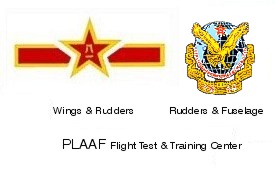 In
1987, the PLAAF established a Flight Test and Training Center at Cangzhou
Airbase, Hebei Province. This center has three primary missions: to test new
aircraft under development by the aviation ministry; to train the pilots in new
type aircraft; and to devise new air combat tactics. In
1987, the PLAAF established a Flight Test and Training Center at Cangzhou
Airbase, Hebei Province. This center has three primary missions: to test new
aircraft under development by the aviation ministry; to train the pilots in new
type aircraft; and to devise new air combat tactics.
The Training Center also established a
blue forces aggressor squadron located nearby to simulate offensive and
defensive operations against the "Red Force".

People's Liberation Army
Naval Aviation
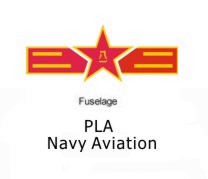 In late
2006, a JH-7 has been noted with a new insignia. Further details are required.
In late
2006, a JH-7 has been noted with a new insignia. Further details are required.
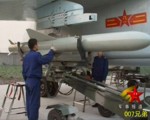 |
|
|
|
|
JH-7 |
|
|
|

People's Liberation Army Air Force
81st Aerobatic Team
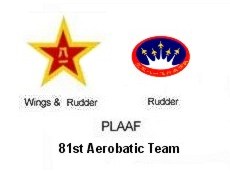 In
2001, 81st Aerobatic Team has received their 2nd batch of J7EB. The color scheme had
changed from red to blue.
In
2001, 81st Aerobatic Team has received their 2nd batch of J7EB. The color scheme had
changed from red to blue.

Hong Kong SAR from July 1st,
1997.
 After
July 1st 1997, China has reclaimed her sovereignty over Hong Kong. Hong Kong Special
Administrative Region was formed. Government Flying Service in Hong Kong started to use
new insignia up to the present day. After
July 1st 1997, China has reclaimed her sovereignty over Hong Kong. Hong Kong Special
Administrative Region was formed. Government Flying Service in Hong Kong started to use
new insignia up to the present day.
 |
 |
|
|
|
Jetstream
41 |
S-70 |
|
|
Part I
|